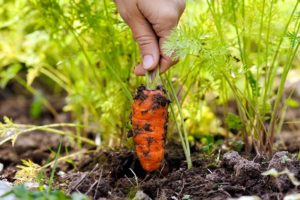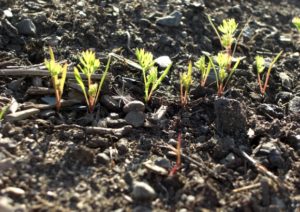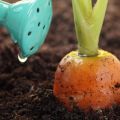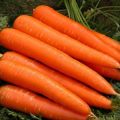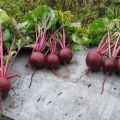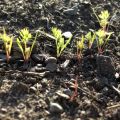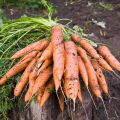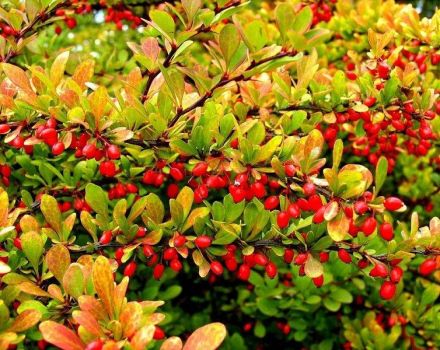When to remove carrots from the garden for storage
If the harvesting of carrots was carried out in a timely manner and reliable storage methods were used, then the root crop can be stored, practically without losing its qualities, throughout the year. Most gardeners prefer to grow a vegetable on their backyard in order to be sure of the ecological purity of the product.
Determining the optimal time for harvesting carrots
Although carrots are not afraid of a decrease in temperature, it is not worth leaving the root crop in the ground until frost. The following factors can influence the timing of picking carrots:
- the state of culture;
- temperature regime;
- features of the variety;
- the purpose of growing.
Each variety has its own ripening period, and then the carrots, which continue to be in the ground, lose their juiciness and sweetness.
It is necessary to take into account the period when biological ripeness occurs. By this time, the carrots should have a certain size and color, in accordance with the varietal characteristics. In bad weather conditions, such ripeness may not come at all, which is often noted in late-ripening carrot varieties. It is necessary to collect carrots when the vegetable reaches technical ripeness. This solution causes a decrease in shelf life and reduces the yield.
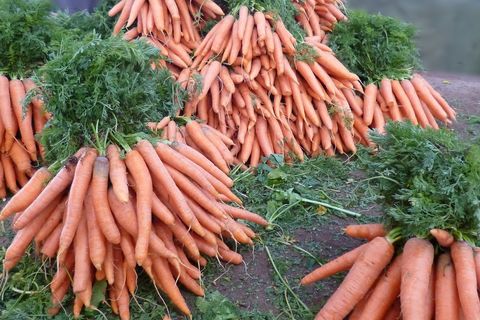
The temperature at which it is necessary to remove the carrots is usually between 3 and 5 degrees. At this point, the roots stop growing, so there is no point in keeping the carrots in the ground longer. The first fall frosts should be a signal when to dig carrots. Experienced gardeners argue that when digging carrots in a warm season, the vegetable may not withstand the temperature difference when moved to the basement.
Rules for collecting late carrots
These varieties are characterized by the end of ripening with a gradual decrease in the average daily temperature. They can be kept in the ground until cold weather.
After a decrease in the average daily temperature in September, the growth of tops slows down, but at the same time, trace elements accumulate in root crops, and carrots ripen.
The vegetable accumulates the maximum amount of nutrients, which helps to increase the shelf life.
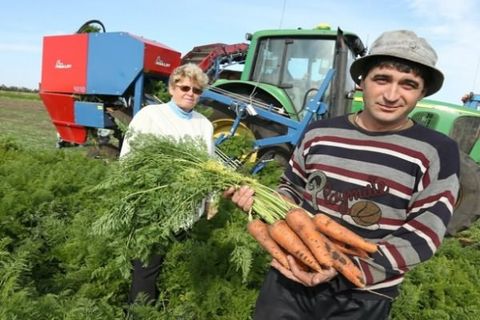
This requirement applies, first of all, to late varieties, in which the growing season lasts more than 110 days. Harvesting carrots can only begin in the second half of autumn. However, when the temperature drops to -3 degrees, there is a likelihood of infection of the crop with gray rot.
Harvesting mid-season fruits
In mid-season root crops, ripeness occurs between 80 and 100 days.These varieties are juicy enough to be used for fresh vegetable salads. These carrots are harvested starting from September 15th. A longer stay in the ground leads to a loss of juiciness and compaction of the pulp.
Early carrot harvest time
The growing time of early carrots is rather short - no more than 80 days. Ripening of such varieties occurs in the middle of summer. Usually, selective collection is carried out as the root crop reaches 1 cm in diameter. Carrots are used in baby food, for preparing salads, and are suitable for eating raw.
The main disadvantage of early varieties is that root crops cannot be stored for a long time. If you keep carrots in the ground for a longer period, the roots crack and lose their taste.

Digging root crops from the ground as needed, it is necessary to bury the formed pits so that they do not cause the carrot fly to penetrate to the nearby root crops.
If all the carrots are removed from the garden at the same time, then representatives of cabbage (cabbage lettuce, bush beans, broccoli, kohlrabi or cauliflower) can be planted in their place.
Typical signs for starting cleaning
Knowing the growing season of a particular carrot variety is not enough to determine exactly when to remove carrots from the garden. It is important to inspect the culture visually. The most characteristic sign that indicates the ripening of fruits is yellowing of the tops, in particular of the lower foliage. If the middle leaves begin to change color, this may mean that the plant is sick or the harvest time has already been missed.
Another clear sign of a ripe carrot is the formation of lateral roots. This feature indicates seed formation. Collection should not be postponed if such signs are present.
Collection rules
Properly organized harvesting will help keep vegetables in proper conditions for a long time without loss of quality. You should stop watering the beds 7 to 15 days before harvesting.
It is better to dig up roots on a fine sunny day, so that the fruits do not get wet in the rain, and then they are better stored. It is advisable to pay attention to the lunar calendar - cleaning is best done on days with a waning moon. According to gardeners, this contributes to better keeping quality of the crop.
Digging and plucking fruits
Small fruits can be removed from the ground by pulling out by the tops without using garden tools. But it is better to pre-dig in elongated root crops with a pitchfork or a shovel. It is advisable to moisten the soil before harvesting, which will simplify the process of pulling root crops out of the ground. After pulling out, it is not recommended to crush the adhered soil by hitting the carrots against each other - this can cause damage.
Dig up the root vegetable by gently pressing on the shoulder of the shovel, as even minor damage to the root vegetable can lead to infection with pathogenic microorganisms and further decay. Digging should be carried out away from the root crop so that the carrots rise along with the top layer of the earth.
Trimming the tops
If you leave the leaves on the harvested root vegetables, the tops gradually draw out the juices from the carrots. The greens should be removed after the soil remaining on the roots dries out.
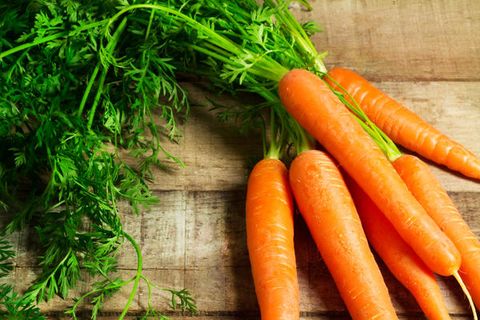
It is better to cut the leaves with a knife. The cut is made along the top, going about 2 mm deep into the root crop, but it is not recommended to pick off the leaves with your hands. This will help keep the crop from germinating prematurely in the spring. If root crops are intended to produce seeds, leave 1.5 - 2 cm of tops.
Drying
The root vegetables, peeled from the tops, are laid out under a canopy in the shade for drying. The next day, you can select sick and damaged vegetables.
Whole and healthy ones are taken away for further laying in the cellar for storage, and it is advisable to use damaged root crops as soon as possible and not put together with the rest of the crop. Frozen specimens should be thrown out, as they lose their ability to withstand diseases.
Do not leave carrots to dry in the open air for a long time. This will cause wilting of root crops, reduce juiciness and taste, and harm keeping quality.
Laying in the cellar
The shelves in the cellar, where the crop will be stored, are pre-treated with a solution of copper sulfate. Carrots can be placed in boxes of calcined sand. The sand is periodically moistened for better preservation of the fruit. Sometimes, instead of sand, sawdust from coniferous trees is used.
In some villages, chalking is used, that is, the roots are dipped in a chalk solution and then dried. Or they simply dust the roots with dry chalk powder. This helps to reduce the likelihood of pathogens entering the fruit.
There is a method of immersing carrots intended for winter storage in a solution of onion peels or immersing root crops in a liquid clay mass with further drying.
Organization of storage
To ensure an optimal temperature regime during storage of carrots in winter, it is necessary to maintain the temperature in the basement in the range from 0 to +3 degrees. Of no small importance is the absence of light and the observance of air humidity within 90%, especially at the initial stage of storage.
Before laying in a cellar, you can withstand the harvest at a temperature of about +12 degrees, and then select the damaged specimens for current needs. Only healthy fruits are stored.
You can store the harvested crop in plastic bags only by carefully drying the carrots. Root vegetables are tightly packed inside polyethylene, and then the bag is tied up. Small cuts can be made for ventilation.
When stored in a box with sand, it is pre-moistened at the rate of 1 liter of water for a bucket of sand. A two-centimeter layer of sand is poured onto the bottom of the box, and roots are placed in it at some distance from each other, and sand is poured on top again.
